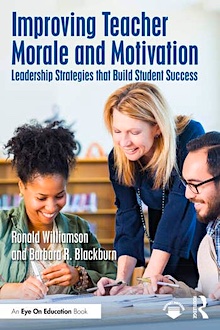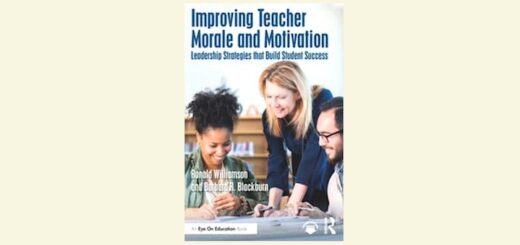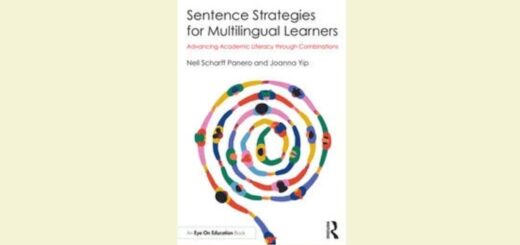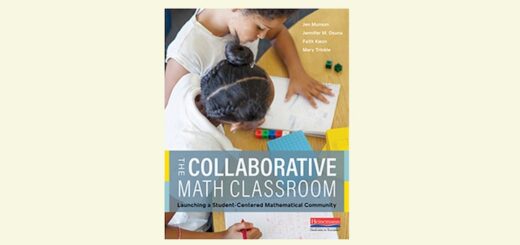Leadership Strategies to Build Teacher Morale
Improving Teacher Morale and Motivation: Leadership Strategies that Build Student Success
By Ronald Williamson and Barbara R. Blackburn
(Routledge/Eye On Education, 2024 – Learn more)
Reviewed by Matt Renwick

Consider one school district where student teachers may soon be hired as teaching interns to fill long-term substitute openings. They simply cannot find enough guest teachers to meet the demand. When teachers face uncertainty about taking extended time off – such as after the birth of a child – how does that affect their confidence in their roles? And what does this say about the broader trust and stability within the teaching profession?

Ronald Williamson’s and Barbara Blackburn’s book Improving Teacher Morale and Motivation provides principals and other school leaders with key insights and strategies for directly addressing this area of need.
Here are three principles from the book that resonated with me as a former principal and an educator currently serving as an external coach for public schools.
Principle #1: Raise Expectations
A common refrain I hear from school leaders when discussing continuous improvement efforts is to “not stress the teachers out too much.” The leaders are worried about resistance to change or even teachers resigning their position.
While I understand the concern, especially after the pandemic, I am also reminded that students in our classrooms today deserve the very best instruction we can offer them.
Williamson and Blackburn list several ways leaders can communicate high academic expectations with teachers and students without dismissing their concerns. For example, the authors share how one principal responded to any request for additional resources:
“How does _______ positively impact student learning?”
Another idea is for school leaders to send out weekly prompts to teachers to encourage regular reflection about their practice.
- “This week…”
- “I learned…”
- “I was encouraged by…”
Both of these examples demonstrate a belief in the teacher as a professional, while also helping them be accountable for their decisions regarding their students.
Principle #2: Be Present
Getting into classrooms and being visible has long been a practice I have promoted as a principal. It’s affirming to see Williamson and Blackburn concur.
“Maximize the time you spend in classrooms. Find time to talk with teachers about their instruction and how you can be supportive. What you pay attention to becomes important in your school.”
When I have suggested non-evaluative visits to classrooms, some school leaders have been hesitant to engage in these practices. One response I have offered is to come into each classroom looking for the good: what’s going well, what shows promise, and where we can learn.
The observations leaders make can be converted into success stories. These narratives shape how students, teachers, and parents perceive the school culture. As Williamson and Blackburn confirm:
“Develop a set of stories about student, and teacher, success. Use every opportunity to share those stories with teachers, families, and community. Add to your collection regularly.”
We are doing our school a service by sharing what we observe through a positive and objective lens.
Principle #3: Become Confident
I wanted to title this section as “be confident,” but I’ve learned through personal experience that it is not that easy.
To become confident, we have to first be courageous and put ourselves out there professionally.
A start is to let faculty and staff know where one stands philosophically. What are you willing to “fall on your sword for” in the name of student learning and equity? Williamson and Blackburn clarify this point.
“Successful school leaders hold a clear vision for their school and act in ways that demonstrate their belief in the vision and its impact on their school community.”
I’ve learned in my years as an administrator that teachers want to know where their principal stands on certain issues. Even if they don’t agree with those positions, they feel they can engage more readily with them when they experience discord.
At the same time, a leader who wants to improve teacher morale and motivation has to be flexible and adaptive to the situations with which they are presented. It’s not just about getting their point across. There has to be some give and take in the exchange. The authors write:
“Leaders must be willing to expand their knowledge, including talking with people who may not agree or support their vision. They must always express confidence in their beliefs but also recognize areas where they must continue to grow as a leader. Confident leaders understand that they may not have strengths in all areas, and they develop a cadre of people they can work with to complement their strengths.”
To summarize, confidence is found not in sticking with one’s position, but by being open to revision of one’s position in light of new information.
The capacity for success
How do these three behaviors – raise expectations, be present, become confident – influence teacher morale and motivation?
In my experience, I have found teachers will come to your school when they know two things: 1) they are able to teach students the best way they know how, and 2) they have opportunities to improve their practice through frequent collaboration with peers and support from leadership. The ideas offered from Williamson’s and Blackburn’s book can create that capacity for success.
Matt Renwick is a systems coach for CESA #3, an education service agency in Fennimore, Wisconsin. During his 20-year career in education, he has served as a principal in two Wisconsin elementary schools and as a middle grades vice principal, teacher and athletic coach.
Matt is the author of Digital Portfolios in the Classroom: Showcasing and Assessing Student Work (ASCD, 2017) and Leading Like a C.O.A.C.H.: Five Strategies for Supporting Teaching and Learning (Corwin, 2022). Available now at his Read by Example substack is Ten Actions for Supporting Teaching and Learning Playbook. Subscribe to his substack and follow him on Bluesky @readbyexample.bsky.social. Read all his MiddleWeb articles here.



































